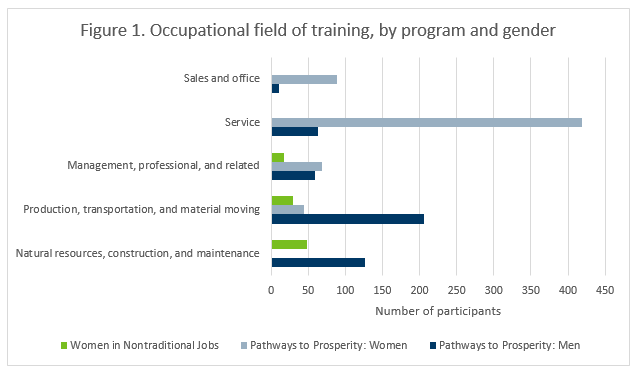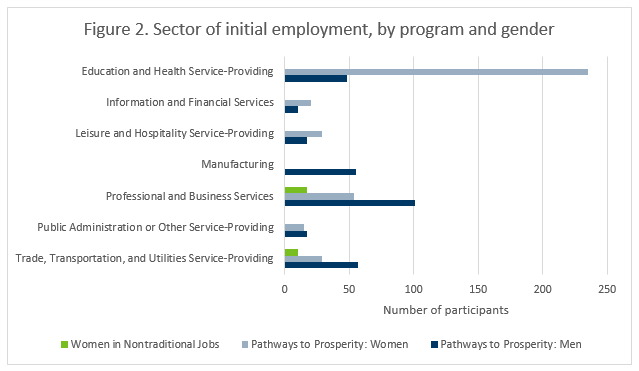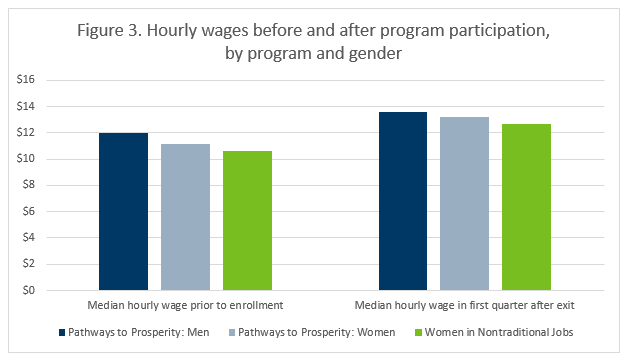Small DEED program makes inroads into occupational segregation
6/6/2017 11:11:00 AM
With summer’s warm days and mosquitos come the orange cones and lane closures associated with road construction. While the gendered “men working” road signs are falling out of favor, they point to a real labor market trend. In fact, highway maintenance is among the most gender-segregated occupations in America, with women comprising less than 2 percent of the workforce.
Compare highway maintenance to child care, another highly gender segregated field where teamwork and safety are critical; 96 percent of child care workers are women. Both occupations typically require just a high school diploma and minimal experience, but child care workers earn an average of $10 per hour, highway maintenance workers an average of $18 per hour, according to DEED’s Occupational Employment Statistics tool.
It’s examples like these that lead social scientists to study whether traditional “women’s work” is undervalued in our labor market, and whether continued occupational segregation only serves to cement stereotypes about what is women’s work and what is men’s work.
Minnesota is embarking on a unique public policy solution to occupational segregation: the Women in Nontraditional Jobs training program, signed into law by Governor Dayton in 2014 as a part of the Women’s Economic Security Act. This program provides training to women in high-wage jobs, like highway maintenance, in which they are underrepresented.
To date, this new program has served 134 women, making it one of the smaller employment and training programs DEED administers. But initial results are in: Women in this program are successfully trained in nontraditional jobs and do find employment in those sectors.
Another training program, Pathways to Prosperity, provides a good comparison when looking at participant data. Both programs target low-income workers with career counseling and retraining, but Pathways to Prosperity serves both men and women and is not explicitly intended to address occupational segregation.
These results cover participants served between July 2015 and June 2016, and are available in the Uniform Outcome report card.
As Figure 1 shows, the women in the Women in Nontraditional Jobs program clearly get trained in male-dominated fields such as construction and manufacturing. In contrast, the occupations of training in Pathways to Prosperity broadly align with traditional occupations. The majority of women in Pathways to Prosperity are trained in service occupations, which includes many jobs in health care and social service, and the most common field for men in Pathways to Prosperity is production and transportation.

Figure 2 shows that the women who participated in the Women in Nontraditional Jobs program are in fact finding employment in the two most popular sectors among men who participated in Pathways to Prosperity. Women who participated in Pathways to Prosperity overwhelmingly find employment in the female-dominated sector of education and health care.
However, because Pathways to Prosperity is a larger program, a larger number of women in that program than in the Women in Nontraditional Jobs program actually found employment in nontraditional sectors.

Do these nontraditional jobs pay off for participants? Figure 3 shows pretty even wage growth across both programs, from earning $10-12 per hour prior to participation to $12-14 per hour after participation. The wage change among female participants in both programs is nearly identical.

So is retraining women in nontraditional jobs a silver bullet for the persistent gender wage gap? Probably not, especially at this level of public investment. But much of the rationale for this program was not just to increase participating women’s wages but to chip away at the notion that men and women belong in different occupations. These changing norms are harder to measure but just as valuable.
Ellen Bendewald is a performance measures analyst with the Performance Management team at DEED.
job training
workforce